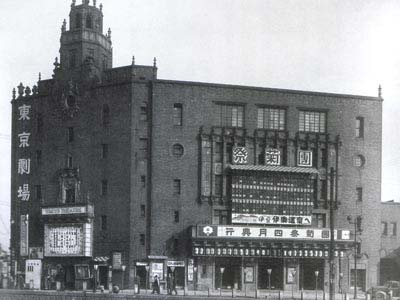| TďKYď GEKIJď |
| Name | T˘ky˘ Gekij˘ T˘geki |
||||||||||||||||||||||||||||||||||||||||||||||||||||||||||||||||||||||||||||||||||||||||||||||||||||||||||||||||||||||||||||||||||||||||||||||||||||||||||||||||||||||||||||||||||||||||||||||||||||||||||||||||||||||||||||||||||||||||||||
| City | T˘ky˘ | ||||||||||||||||||||||||||||||||||||||||||||||||||||||||||||||||||||||||||||||||||||||||||||||||||||||||||||||||||||||||||||||||||||||||||||||||||||||||||||||||||||||||||||||||||||||||||||||||||||||||||||||||||||||||||||||||||||||||||||
| History |
1930: opening of the T˘ky˘ Gekij˘ in the district of Tsukiji. It was a modern 1898-seat theater, which was managed by the Sh˘chiku Company and designed for Kabuki, Western Operas or movies. July 1931: premiere at the T˘ky˘ Gekij˘ of Hasegawa Shin's drama "Ippon Gatana Dohy˘ Iri", which was staged with the following casting:
September 1933: premiere at the T˘ky˘ Gekij˘ of the Nagauta-based ky˘gen "Takatsuki", which was adapted for Kabuki by Hisamatsu Issei (lyrics) and Kashiwa Izabur˘ (music) and performed by Onoe Kikugor˘ VI and Band˘ Mitsugor˘ VII. October 1933: premiere at the T˘ky˘ Gekij˘ of Yoshida Genjir˘'s drama "Nij˘-j˘ no Kiyomasa", which was staged with the following casting: September 1933: premiere at the T˘ky˘ Gekij˘ of Kawamura Kary˘'s drama "J˘shű Miyage Hyakury˘ Kubi", which was staged with the following casting:
January 1934: premiere at the T˘ky˘ Gekij˘ of the third (and final) part of Mayama Seika's drama "Edo-j˘ S˘zeme", which was entitled "Sh˘gun Edo o Saru" ('The Sh˘gun Leaves Edo') and was staged with the following casting:
April 1934: premiere at the T˘ky˘ Gekij˘ of Kimura Tomiko's Tokiwazu-based dance "Hanami Yakko", with a choreography and a musical accompaniment made by Hanayagi Jusuke II and Tokiwazu Mojibŕ III. The leading role of the yakko was played by Ichikawa Ennosuke II. June 1934: premiere at the T˘ky˘ Gekij˘ of Hasegawa Shin's drama "Kurayami no Ushimatsu", which was staged with the following casting:
January 1935: premiere at the T˘ky˘ Gekij˘ of Uno Nobuo's drama "Fubuki T˘ge", which was staged with the following casting:
January 1935: premiere at the T˘ky˘ Gekij˘ of "Edo-j˘ no Ninj˘", the first play of Mayama Seika's cycle "Genroku Chűshingura", which was staged with the following casting:
January 1935: premiere at the T˘ky˘ Gekij˘ of "Daini no Shisha", the second play of Mayama Seika's cycle "Genroku Chűshingura", which was staged with the following casting: April 1935: premiere at the T˘ky˘ Gekij˘ of "Saigo no Daihy˘j˘", the third play of Mayama Seika's cycle "Genroku Chűshingura",. which was staged with the following casting:
April 1936: premiere at the T˘ky˘ Gekij˘ of "Ninin Sanbas˘", a 2-dancer version of the Sanbas˘ dance, starring Ichikawa Ennosuke II and his son Ichikawa Danshir˘ III. January 1937: premiere at the T˘ky˘ Gekij˘ of Mayama Seika's drama "Meikun Gy˘j˘ki", which was staged with the following casting:
May 1938: premiere at the T˘ky˘ Gekij˘ of Mayama Seika's drama "Katsu Awa no Chichi", which was staged with the following casting: February 1939: premiere at the T˘ky˘ Gekij˘ of the second act of "Sengoku Yashiki", the ninth play of Mayama Seika's cycle "Genroku Chűshingura. It was staged with the following casting:
November 1939: premiere at the T˘ky˘ Gekij˘ of Kimura Tomiko's dance-drama "Kurozuka". The musical accompaniment was written by Kineya Sakichi IV and the choreography was made by Hanayanagi Jusuke II. This dance-drama was staged with the following casting:
January 1940: premiere at the T˘ky˘ Gekij˘ of "Ohama Goten Tsunatoyo-ky˘", the fifth play of Mayama Seika's cycle "Genroku Chűshingura", which was staged with the following casting:
April 1941: premiere at the T˘ky˘ Gekij˘ of Kimura Tomiko's Gidayű-based dance "Yoi Yakko". The leading role of the yakko Bekunai was played by Ichikawa Ennosuke II. November 1941: premiere at the T˘ky˘ Gekij˘ of "Sengakuji no Ichinichi", the eighth play of Mayama Seika's cycle "Genroku Chűshingura", which was staged with the following casting:
November 1941: premiere at the T˘ky˘ Gekij˘ of Kimura Tomiko's Nagauta/Gidayű-based dance "Futari Tomomori", which was staged with the following casting:
10 March 1945 (00:08 AM): 344 US Army B29 bombers dropped 2,000 tons of bombs on T˘ky˘, killing more than 120,000 people and destroying almost everything; the T˘ky˘ Gekij˘ was the sole standing theater in the devastated city. February 1946: Ichimura Kakitsu VII and Ichimura Matasabur˘ II took at the T˘ky˘ Gekij˘ the respective names of Ichimura Uzaemon XVI and Ichimura Kakitsu VIII. May 1947: revival at the T˘ky˘ Gekij˘ of the drama "Jayanagi", which belongs to the Kabuki Jűhachiban collection of drama. It was staged with the following casting:
May 1949: premiere at the T˘ky˘ Gekij˘ of the dance-drama "Higaki", which was staged with the following casting:
September 1949: Ichikawa Somegor˘ V and his son Matsumoto Kintar˘ II took the respective names of Matsumoto K˘shir˘ VIII and Ichikawa Somegor˘ VI at the T˘ky˘ Gekij˘. 1952: the T˘ky˘ Gekij˘ became a movie theater. 1975: the T˘ky˘ Gekij˘ was rebuilt and modernized. Its name became T˘geki. |
||||||||||||||||||||||||||||||||||||||||||||||||||||||||||||||||||||||||||||||||||||||||||||||||||||||||||||||||||||||||||||||||||||||||||||||||||||||||||||||||||||||||||||||||||||||||||||||||||||||||||||||||||||||||||||||||||||||||||||
 |
|
The T˘ky˘ Gekij˘ in 1947 |
|
|
| Contact | Main | Top | Updates | Actors | Plays | Playwrights | Programs | Links | FAQ | Glossary | Chronology | Illustrations | Prints | Characters | Derivatives | Theaters | Coming soon | News |